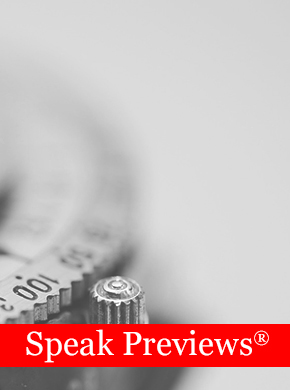The speaker began with a few hearty blows into the microphone and then looked out at his audience. "Is this thing working?" he asked. He tapped a finger on the head of the microphone. "Is this thing working?"
If you've ever seen a presentation start like that, you know it's not the most effective way for a speaker to begin. If you've ever been the speaker blowing, tapping, and throwing out sound-check questions, you knew that you weren't off to a very compelling start.
Find out ahead of time what type of microphone will be available; rehearse with that type and, if you can arrange it, conduct a sound check before listeners arrive.
No matter which kind of microphone you use, become familiar with the on and off buttons. You don't want to broadcast private comments, nor do you want to discover halfway through your beginning remarks that the mic is off.
A lavalier mic clips to the speaker's clothing, so wear something that smoothly accommodates it—a tie, a jacket, an open cardigan. If the lavalier mic is wireless, provide a place for a transmitter to be attached—a back pocket, a belt, the waistband of a skirt or pants.
While a headset mic will go where you go, a lectern or stationary mic is fixed to the surface of a stand. But with either, your face should be clearly visible to your listeners; its expression helps convey messages, both their content and tone. You should be able to gesture, too, without knocking into the microphone.
A fourth type in frequent use is the handheld mic; most are now cordless. As with a lectern mic, make sure it doesn't block your face.
Although each kind of mic demands specific positioning, they share the need for the speaker to preserve a consistent distance. So even as you turn, shift eye focus, or gesture, maintain the same amount of space between you and the mic.
Most lavalier mics work best placed at the center of the body, eight to ten inches below the chin. If you're using slides, fasten the mic slightly towards the side where the screen is located since you'll sometimes be looking at it as you speak. To determine the voice pickup zone of a lavalier, imagine that the base of the letter "V" is at the microphone. You can move your head within that "V" and be heard.
Adjust the arm or voice tube of a headset microphone so that the mic itself is an inch or two from the side of your mouth.
At a lectern mic, position yourself ten to twelve inches away from the mic and keep it slightly below your face. If you get too close, the mic will amplify your every breath, every click or hiss of the words you pronounce. Give it space; it will capture your voice so long as sound flows over or across it. When you are looking to the left, step slightly to the right (and vice versa) to maintain a consistent distance between you and the microphone.
Keep a handheld mic approximately three to four inches under your chin. Speak over or across the microphone, not into it.
A microphone need not stand between you and your listeners. Engage it to engage them.



